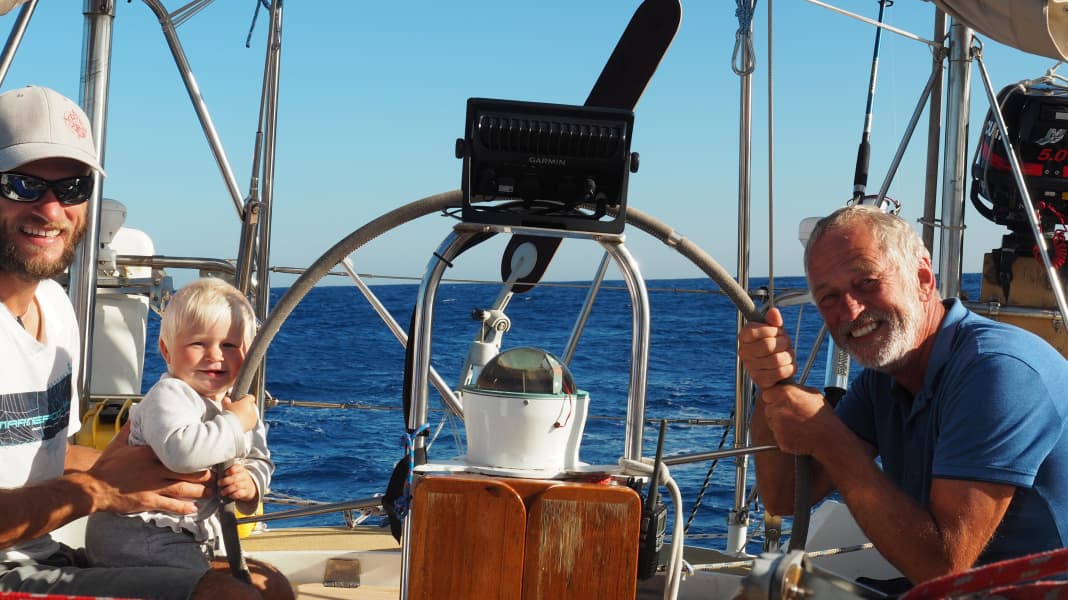
Somewhere in West Africa a year ago. Our "Aracanga" is moored at a buoy in the river and we are waiting on the shore in a pub that is poorly lit by candlelight due to a lack of electricity for the friendly gentleman with the cotton buds to test us for coronavirus. "Good evening, I'm Ibrahim from the Ministry of Health. Do you have corona?"
"Good evening. Er, I don't think so..."
"I think so too. Then we can save ourselves the trouble of doing the tests. I'll bring you the certificates tomorrow lunchtime."
"All right. Thank you."
Ibrahim drives up on time the next day in his battered red 190 and hands us the negative test certificates. We tick one last box on the long list of documents that we have to present when we enter the country on the other side of the Atlantic. We want to go to the Caribbean. But cruising has definitely not become any easier in times of the coronavirus pandemic, nor has it become any more affordable. At the equivalent of 50 euros per certificate - delivery service included - the tests in West Africa are the cheapest and least complicated.
Nothing with a train to the flight
Almost a year earlier, somewhere in southern Germany. It's March 2020, we're on holiday at home. We're sitting on the swing in front of our parents' house, rocking ourselves and the reason for our holiday, our two-month-old daughter, and thinking about how to get back to our floating home. It is nine metres long and is waiting for us at a buoy in the Gambia River. Our booked train and train tickets are cancelled and almost every other scenario for getting back to West Africa also fails due to coronavirus. All but one: sailing.
As luck would have it, my dad has recently retired and wants to spend his new freedom on the water. His boat, the "Ivalu", is again a good old friend of mine. Ten years ago, I sailed around the world on her for three years. The solution is obvious and we kill several birds with one stone: the more extensive than expected equipment for Kira, our smallest crew member to date, fits just as generously on the 42 feet of the "Ivalu" as our small family. With three adults, night watches and babysitting can be divided up in a relaxed manner, giving us a stress-free start to cruising as a family and my dad to blue water sailing.
One family, two boats, three generations,
Four crew members, five months, six countries. Our sailing adventure originally started in the summer of 2018, sailing from Germany through the French canals and the Mediterranean to the Atlantic. We continued via Morocco, the Canary Islands and Cape Verde to Senegal and The Gambia. We spontaneously decide to visit home from there, which brings us unplanned to the starting point of this second journey, the journey within the journey. While our 30-foot "Aracanga" floats in another part of the world, the "Ivalu" becomes our home for the next five months. Multi-generational households are all the rage, so why not a multi-generational crew? Daughter Kira, mum Riki, dad Martin and granddad Peter complete the family crew.
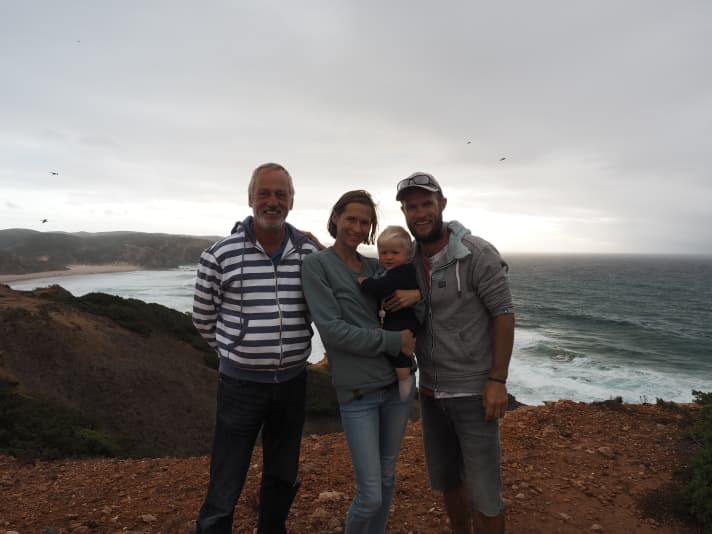
Hamburg-Harburg. This is where our journey starts and, as with every cruising crew at the beginning, we have to pack, tidy up, clear out, rearrange and stow away again: Clothes and spare parts find their place, as do food, water and diesel. For Riki, Kira and me alone, there are four laundry baskets and two travel bags full of stuff: in addition to baby clothes in various sizes for the next six months, we stow a basket of cloth nappies in the lockers for the sake of the environment, plus whatever of our own clothes is not in the "Aracanga"'s clothes locker. In addition, sea boots, life jackets, oilskins and the like and, last but not least, a basket full of spare parts for our own boat.
Departure. In terms of coronavirus, the waving crowd at the jetty is very small, but all the more persistent: harbour master Björn, berth neighbour Basti and dog Seemann wave tirelessly until we are finally allowed to enter the lock to the Elbe after the fourth lap of honour. In keeping with good old tradition, we once again head for the sea on a river. Between tankers, freighters and barges, we head down the Elbe, from the Süderelbe into the main river and shortly afterwards hard to port again into the Köhlfleet. There we are moored at a small jetty, the water is wonderfully calm and with a little imagination, despite the morbid heavy industrial charm, it almost feels like we are in the middle of nature.
Our good friends, who accompanied us two years ago, are also back for this first leg. Their "Hein Mück", known from YACHT 6/2022, just needs to be slipped and rigged again. We feel a bit like the tourists from Bavaria as guests on an NDR home programme, as a couple of genuine Hanseatics manoeuvre the "Hein Mück" onto the slip ramp with a few skilful moves and plenty of Hamburg chatter. "Now we wait for the time and then the boat floats." And so it is, in the late afternoon the "Hein Mück" lies next to the "Ivalu" on the jetty - and we are flat in our berths.
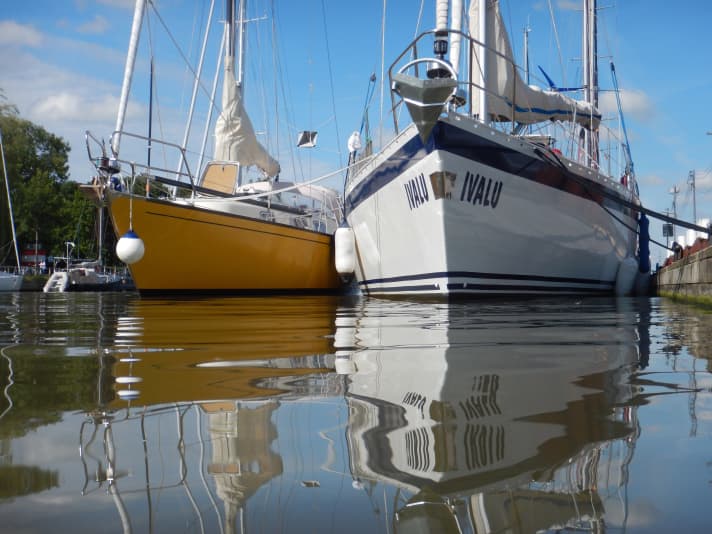
North Sea
Hamburg - Brunsbüttel - Cuxhaven - the tide is in our favour and we don't have to get out of our berth at night to take advantage of the ebb current. Instead, we set off for Helgoland in beautiful summer weather. Sailing at last. We wish we could. The wind gauge shows between zero and five knots and we chug across a mirror-smooth sea. The calm weather also has its advantages: a harbour porpoise appears here, a seal there, and we have a cup of coffee and biscuits.
Little by little, Heligoland peels out of the haze. A green buoy to starboard, a red one to port, and we are already in the harbour and moored next to our friends in the packet. "Riki, Martin!" it calls over. In front of us is a large catamaran that somehow looks familiar. We are delighted to see each other again; we got to know the boat and the crew over a year ago in Morocco and met them again a short time later in the Canary Islands. It's a small world, the sailing world in particular.
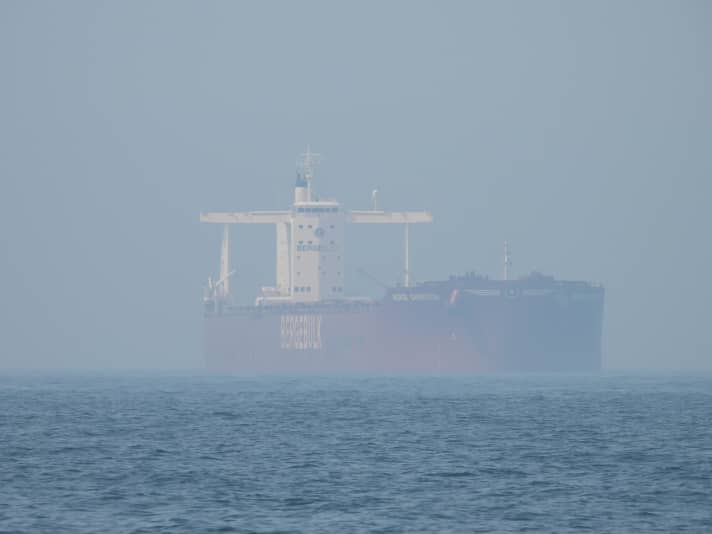
We spend three days on Heligoland, visit the gannets on the Lummenfelsen, photograph the Lange Anna and cross over to the dune on one of Heligoland's traditional Börde boats.
Course Borkum
But now, finally sailing. In order to arrive with the right tide and still in daylight, we set off at four in the morning. The wind is blowing at a fresh 20 knots. It begins to dawn in the east shortly after setting off and, under full sail, we rush into the morning with a pot of hot coffee in our hands. We switch from the genoa to the jib and enjoy the feeling of being underway despite the somewhat rough, short wave.
The entire crew and baby pass their first test. We sail through the Riffgatt, a buoyed passage over the Borkum reef, towards the island of the same name and along its western side. With the mudflats on one side and the island on the other, we sail the last few metres to the harbour. The harbour is unexciting, but a little more expensive. So onwards, up the Ems to the Dutch town of Delfzijl. This is where the "Staande Mastroute" begins, a canal route across the Netherlands. The highlight: as the name suggests, the entire route to Rotterdam can be travelled with a standing mast. To be honest, this sounds like a pleasant alternative to the not always so cosy North Sea.
Sails down, engine on
The sun is shining, the laundry tub sails along on deck as a baby bath and, like in a film, one town passes us by more beautifully than the next. Groningen - Dokkum - Leeuwarden - Lemmer - Enkhuizen - Amsterdam: This is the first part of the inland journey and, provided you have enough time, each stop harbours a new highlight. Basically, the towns with their narrow streets, bridges, locks and canals are all very similar and yet each one is extremely attractive in its own right. The flat countryside is crossed by canals and lakes, known here in Holland as seas. Wide reed belts line the banks, behind which cows and sheep graze and here and there is a windmill, sometimes a classic one and sometimes a modern one. Only our draught makes the inland journey exciting at times. "Two metres? No problem with a little momentum!" says the harbour master in Zoutkamp with a wink, "the bottom 20 centimetres are a bit thick."
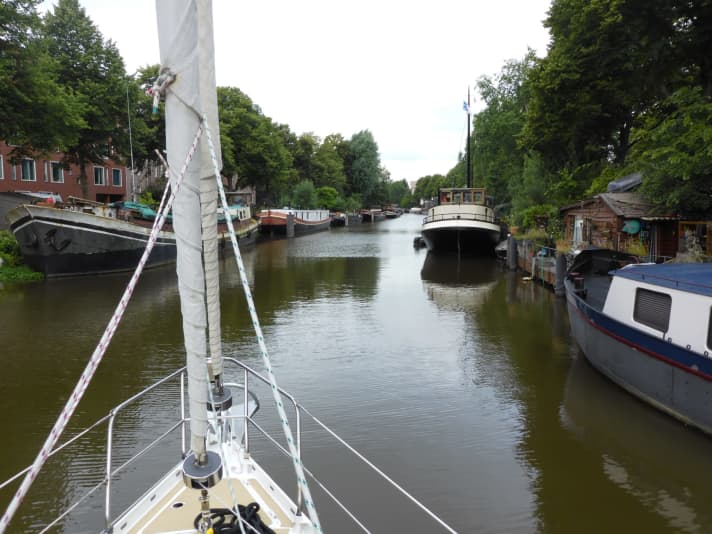
We've been on board for about three weeks now and you can see it most clearly in our smallest crew member Kira. She has been sitting for a few days now, is happy and, as long as she is not tired or hungry, is always in a good mood. Instead of a pushchair, we have a carrier for trips ashore and she prefers to take her afternoon nap in the little hammock above the chart table. During the day, she sits between cushions in the cockpit and cheers on the colourful wind turbine to perform at its best. The tour along the Staande Mastroute is ideal with a baby, there is still little movement and sloping in the boat and there is enough time to settle in before heading out to sea. For now, we are content with short sailing stages on the Dutch inland seas.
From Amsterdam, the tourist centre of the Netherlands, we chug via Haarlem and Gouda, the city of cheese, to the country's industrial centre: Rotterdam. The Erasmus Bridge, one of the city's landmarks, opens especially for us and a few metres further on we turn into the Veerhaven. We are instructed to moor with the bow pointing outwards, following the old tradition. We stay here for two nights, visit the famous market hall, which unfortunately lacks a bit of flair like many other places due to the coronavirus, and prepare the boat so that we can finally set sail again in the next few days for a change from chugging along the canal.
We head out to sea via Europoort for the first night cruise. The North Sea flashes and glows like a gigantic laser show. However, we still lack the peace and quiet to enjoy the spectacle. The red warning lights of the wind turbines flash in unison. The countless ships sailing around us are difficult to recognise and not all of them can be seen on the AIS, which is why we keep a particularly close watch.
The harbour approaches of Antwerp, Zeebrugge and Ostend are on the port side, the anchor berths are on the starboard side and there is a lot of traffic between the anchor field, the traffic separation scheme and the harbour. Two large suction dredgers deepen the fairway, joined by a few fishing boats, which, when they are not busy hauling in their nets, do not show much consideration for others. It's a wonder that they pull anything out of the sea at all, given the constant background noise of the ships' diesel engines, the pollution of the air and water and the sheer number of their kind.
After the narrow passage between Brest and Dover, it suddenly becomes more relaxed and on the third night we can clearly see the Barfleur lighthouse and the lights of Cherbourg, our destination. Night approaches are always exciting. Every lighthouse and every buoy has its own identification. Barfleur: two flashes every ten seconds. More beacons follow until finally the lights of the approach buoys from Cherbourg harbour come into view.
Go on, go on
Weather lottery, that's how you can describe our stay in Cherbourg in a nutshell. Every day we check various wind and weather forecast models and every day we come to the conclusion that we will probably be staying a few days longer. One low-pressure system after another chases by, usually bringing strong westerly winds and an unpleasant wave. Not conditions in which we enjoy being outside and battling the elements.
Two other boats left yesterday, which we track on the AIS. They turn just outside the roadstead and come back, two hours later they are back in the harbour. "Too much wave." Today is our day. At last. We cast off at nine o'clock in the morning. It's still blowing hard and the waves we see through the harbour exit and in the forecasts don't give us much reason to look forward to the English Channel. Wrapped up in lifejackets and oilskins, we take a few showers in the cockpit. It's a bit like a washing machine on spin cycle.
Riki stays below deck with Kira, down here there is less washing and more spinning. The two of them are not feeling well. "I feel sick, you have to change the little one." Wedged in and in no time at all, the baby is fresh again, but I'm as pale as the fresh nappy. Welcome to family sailing, where's the romance?
After the island of Alderney, as if someone had flipped a switch, the sun comes out and the waves drop considerably. Now the fun part of the crossing begins. The wind blows constantly until the next morning and the sun dries and warms. It's cold at night, but a few layers of long underwear and two pots of hot tea make the temperatures bearable. At eleven o'clock the next morning we have the Ile d'Ouessant ahead of us and not much later we moor in Camaret sur Mer. Just four days after our arrival, we set off again together with two boat friends. Over the Bay of Biscay, which is notorious for wind and waves, there is a stable area of high pressure over the next few days with a relatively constant shifting wind from a northerly to easterly direction. A weather window like this in this area is a gift and although we really like Brittany and could easily stay here for a while longer, we set sail early on Saturday morning for A Coruña in Spain.
The Biscay
We divide the night watches so that Riki primarily looks after the little one and Peter and I look after the boat. As long as we are three adults, we can allow ourselves this luxury. We extend the night to 14 hours and divide it into two long wakes of seven hours each, which suits us better than several shorter wakes of three or four hours and sleeping in stages in between. The nights are cold, beautiful and unspectacular, there is relatively little wind at night and sometimes a lull, but we would rather bob along slowly under sail than start the noisy engine.
Just like us, Kira enjoys her sailing days and doesn't seem to mind the movement of the boat. She is now very stable on the floorboards in the saloon or on our bunk and loves to play with anything that isn't a baby toy: pulleys and blocks, lines, winches and cranks.
After three days and two nights, we reach Spain. Before setting off, we thought long and hard about whether we should stop here at all due to the high number of Covid-19 infections. In the end, we decided to call at A Coruña and perhaps one or two anchorages in Spain, but to forego extensive city strolls, pub visits and the like.
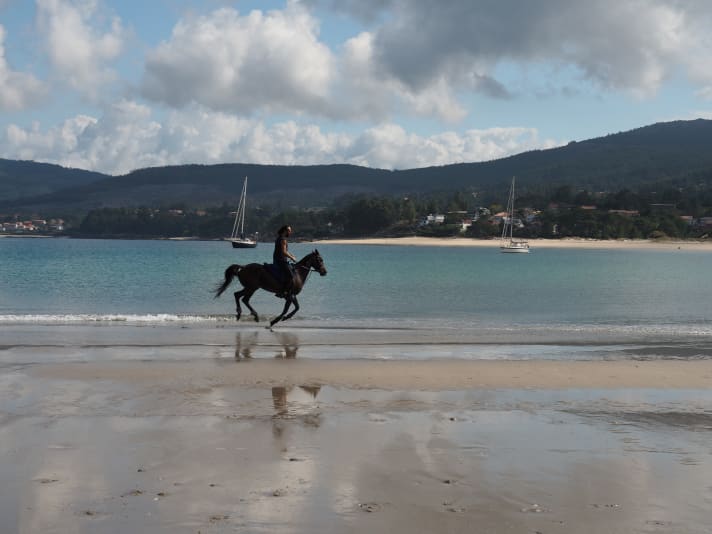
It's a shame that autumn is behind us. The north-west of Spain is beautiful and invites you to spend more time there. On this coast, one anchorage bay follows the next. The deep, fjord-like inlets, often estuaries, are called rias and offer dozens of anchoring possibilities. No matter which direction the wind and waves are coming from, you will always find a safe and sheltered place to spend one or a few nights at anchor. White sandy beaches, barren rocks, mighty capes and idyllic fishing villages alternate and characterise the image of Galicia and we sail along the coast in daylight hours.
Our course changes from west to south. We continue along the Portuguese coast towards the Algarve. We stop in Porto and leave Lisbon behind with a heavy heart due to the high Covid numbers and exit restrictions. Next stop: Lagos. Here we learn that Gambia, the destination of our journey, has reopened its borders. The prospect of seeing our own boat again soon is palpable. The Algarve spoils us with wonderful anchorages, sunshine and summery temperatures.
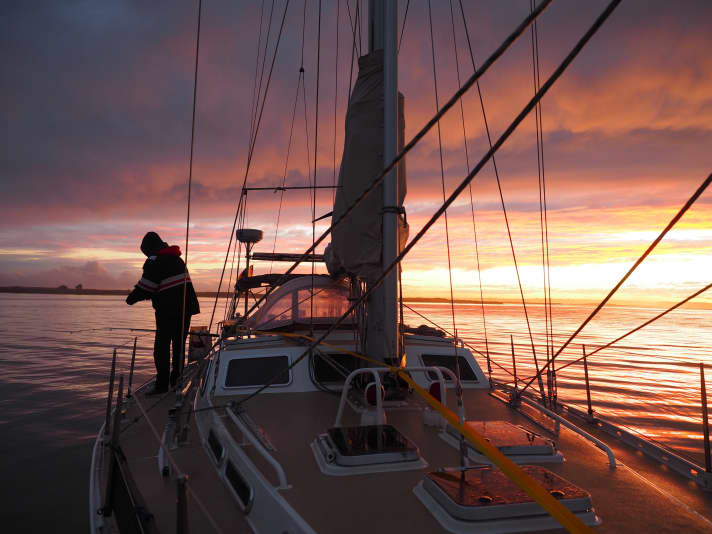
We are particularly fond of Alvor. The entrance to the lagoon with its many sandbanks is exciting. We see two fairway buoys: an apparently red buoy with a green top mark, which we treat like a red buoy and leave on the port side, and a rusty buoy without a top mark, which is green according to the nautical chart but looks red because of the rust. Both the journey through the shallow lagoon and the anchorage give us a little Gambia feeling: Just like in front of the "Lamin Lodge", where the "Aracanga" is moored, a wide variety of states of decay can also be observed here: From chic, highly polished catamarans to long-abandoned boats lying on the sandbank or those with only the top of the mast sticking out at low tide, everything can be found.
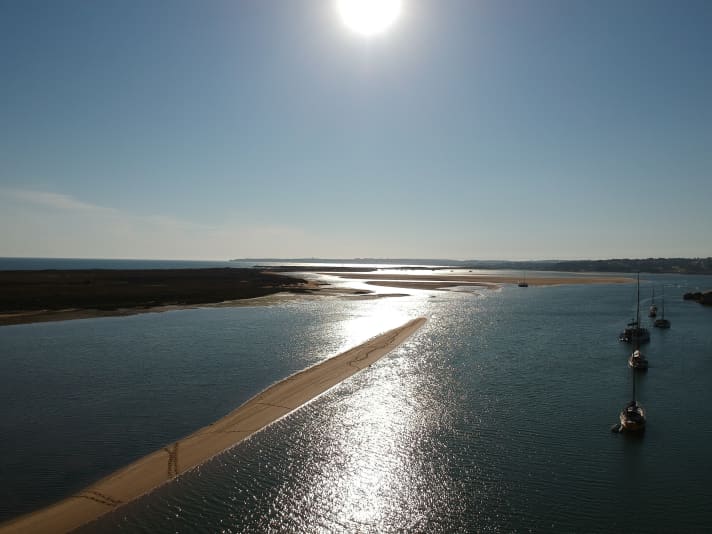
The Algarve is not called the place that eats cruisers for nothing. Many long journeys end here before they even really begin. We can understand that. But despite its beauty, we have no intention of staying here. Our next destination is the Canary Islands.
Away from the coast
We set sail from Portimao on Friday morning and set sail in the estuary. We have 530 nautical miles ahead of us across the Atlantic. Contrary to the forecast, which predicts very little wind for the first day, we have perfect sailing conditions with winds of 10 knots at the start and then between 15 and 20 knots throughout, gusting up to 25 knots.
With the mainsail on port and the genoa unfurled on starboard, we sail directly downwind at an average speed of six knots, which means a daily total of 144 nautical miles. An irregular swell buffeted us a little, but all in all we enjoyed the best sailing conditions and great weather. Mile by mile we get closer to the Canary Islands. It's nice and warm during the day and with every mile southwards, the nights become more pleasant despite our long underwear and oilskins. At the same time, the full moon rises in the east and the sun sets in the west and we don't know where to look in amazement, to port in the direction of the glowing red moonrise or to starboard, where a no less spectacular sunset colours the sky and clouds.
During the crossing, we are all to ourselves and live in our own little world. This is exactly what makes a crossing so appealing, the outside world is switched off and life is simple and elementary: wind and weather, sun and moon set the rhythm and we are not interested in anything else.
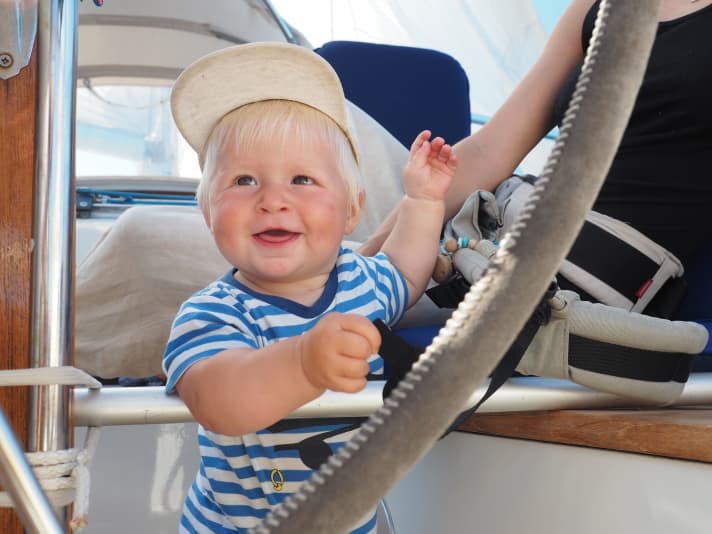
Before setting off, we wonder what it will be like for Kira when everything is rocking while she is learning to stand and shimmy forwards. To our astonishment, it's no problem for her at all; she stands in the cockpit at her "ballet bar", laughing and happy and waving at the waves rolling past. All in all, it is a very relaxed crossing with the little one, who naturally needs a lot of time and attention, but is in a good mood despite the rocking, wind and waves and does her crawling, standing and walking exercises.
After four days, we drop anchor in three metres of water off the island of La Graciosa in the Canary Islands. Two years ago, we were moored in this bay with the "Aracanga". Now we are 530 nautical miles closer to it. It was a wonderful crossing and we are looking forward to paddling ashore and feeling the sandy beach under our feet.
The Canary Islands
Our neighbour comes paddling up in the dinghy and knocks on the side of the boat. She comes from the New Zealand boat next to us and introduces herself. A family with two children, they have been living on board for almost ten years. We recognise her from somewhere. We find the answer later: she wrote an article about nappies on board in a book about sailing with children, which we also have on board. At the time, we said: "That's cool and easy, the way they do it, that's how we do it too."
And while we're on the subject of washing nappies, here's how our washing machine works: we put the dirty nappies in a net and hang it over the stern in the water, whether at anchor or underway. The nappies are pre-washed well by the current and waves, then there is another wash cycle with a little biodegradable detergent in the bucket and finally everything is rinsed out once with fresh water. The sun takes care of drying and bleaching.
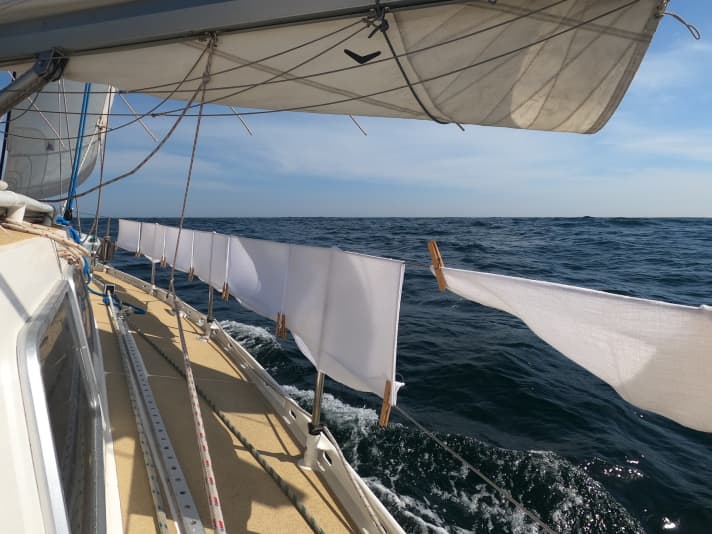
From La Graciosa we sail via Lanzarote, Lobos and Fuerteventura to Las Palmas, where we do the same as a thousand other boats around us: provisioning, waiting for spare parts and trying to understand the Canarian customs and postal system.
Course Africa
We travelled just under a thousand nautical miles in six and a half days from Las Palmas to Banjul. The wind gauge usually shows between 20 and 25 knots, sometimes up to 30, and waves between two and five metres high regularly send the "Ivalu's" log soaring into double figures.
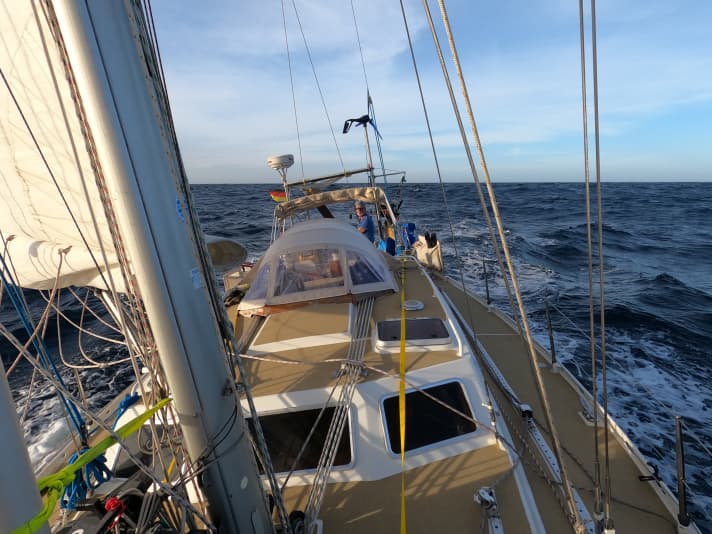
Sailing with a baby is a lot of fun, but also exhausting, as someone always has to be with the little one. The swell doesn't bother her, and no matter how much the "Ivalu" rocks, Kira stands in the small space between the cockpit and the companionway, holding on to the step with one hand and waving at the waves rolling in from aft with the other. And when a seabird flies past, she is beside herself with excitement, showing her one tooth, calling and shrieking, happy and waving even more exuberantly. Putting her to bed is difficult. She usually falls asleep in the carry cot during the strong rolling movements. The trick then is to put her down in such a way that she neither wakes up nor tumbles out of the bunk in the big waves that regularly put the boat far to one side.
Each day, the waning moon rises a little less than an hour later, so the nights get darker and darker during the crossing. But the nights are also getting warmer. We still wear oilskins at night because of the splashing water, but the long underwear stays in the locker.
The wind picks up to 35 knots and most of the time we only sail under a single reefed mainsail, which allows the "Ivalu" to lie balanced on the rudder and the wind vane steering to work reliably. We no longer use our large genoa at all, only the jib from time to time when the wind drops below 25 knots. Every day we make distances of over 150 nautical miles and sail at an average of over six knots. We still have 300 nautical miles to Banjul and we expect to arrive in two days.
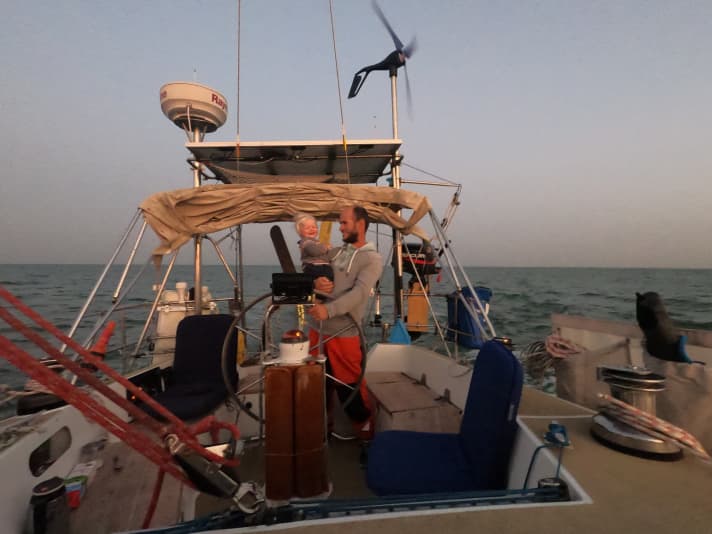
Then we do what we have advised so many others not to do: We sail into the Gambia estuary towards Banjul in the dark. The last night is exciting, but no surprise. All around us there are flashes and flashes of light, hundreds of small and large pirogues are travelling along the Senegalese and Gambian coast. In order to be seen better, we switch on the steamer light in addition to the navigation lights, which illuminate our foresail. It is impossible to estimate the distance to the pirogues. One moment you think the boat with the three white lights is still a long way off, the next moment three fishermen with headlamps are standing in their pirogue just a boat's length away from us. Another pirogue comes towards us at full speed, with an open fire on deck where tea is being made and cooked. They turn so close to us that Riki can see the sparks from below deck and I could shake the helmsman's hand. He grins broadly at me and welcomes us exuberantly: "Welcome to Gambia! Inimbara, inimbara!" With trembling knees, I shout "Inimbara!" back.
The boat is packed in a crust of salt. At 8.45 a.m., the anchor is at a depth of five metres off Banjul. There is a lot going on in the harbour, fishermen in their colourful pirogues are loading their catch and large freighters are unloading cargo. We are told on the radio to come ashore for clearance. We pump up the dinghy, pack our passports and ship's papers, plus mouth and nose protection and, wisely, a clinical thermometer, as a temperature check is mandatory.
We receive a friendly welcome at the gate: "Inimbara. I recognise you, you were here before." The security guard notes down our names and ID numbers and wants to take our body temperature. Fortunately, we have our clinical thermometer with us, otherwise we would probably have to wait here for a long time. A lady from immigration then escorts us through the busy commercial harbour. A harbour worker sits in the top container of a high stack and throws individual packets of cornflakes to his colleague on the ground, who in turn loads them into a tuk-tuk. Large lorries loaded with cement manoeuvre rapidly through the narrow lanes between the containers and there are repeated honking concerts and dusty evasive manoeuvres. And next to them, in the shadow of another container, a group of customs officials sit drinking ataja, the traditional tea. Welcome to Banjul. What a contrast to the lonely week on the ocean that lies behind us!
We turn two corners and step through the door of the immigration office. Five officials are sitting in a circle, one is dozing, one is reading a newspaper and three are chatting and drinking Ataja. In the corner, a fuzzy science fiction film flickers on an old tube television. "Welcome. I recognise you!" Babu, the head of the group of officials, has even saved my mobile phone number. The rest is quick and uncomplicated and once we have our passports stamped, Babu accompanies us two doors down to the health officer.
Here we encounter the type of official you hope not to meet: Patronising, imperious and corrupt. "Where are your Covid tests?" We don't have them. We were told by two official bodies, the harbour authority and immigration, that only body temperature is taken when entering the country by boat. He's not interested. It's impossible to find out what the official situation is and whether the entry regulations have changed during our crossing, the structures here are too opaque. He knows this and takes advantage of it. In the end, we agree to an exorbitant tip on the condition that our friends, who are also on their way to Banjul, can enter the country without any problems.
After the health department, the next stop is customs. The head of customs in the harbour also remembers us. "You know the procedure." Yes, we know the procedure. We have a cup of tea, he is happy about a new cap and we are happy to be cleared in quickly and easily.
The last stop in the clearance marathon is the harbour authority, where Gibba, the head of the pilot boat drivers, waves to us from the top floor. He even gives us an official receipt for the cruising permit. After six hours, we have officially entered the country. There's nothing stopping us now. Full of anticipation for our old new home, we pick up the anchor of the "Ivalu" and make our way to Lamin Lodge, where we left our "Aracanga" a year ago.
Reunion
"Good to see you back!" Lamin, a fisherman friend, comes to meet us in his pirogue and recognises us immediately. The joy of seeing each other again on land is also huge. The news that we are back has already travelled ahead of us and as we row our dinghy to the jetty, many friends are already waiting for us with loud shouts of "Papa Peter, Captain Martin, Ladyboss and Baby Kira". It's a bit like coming home. Corona or not, we fall into each other's arms and the small bar behind the mangroves is open a little longer than usual today.
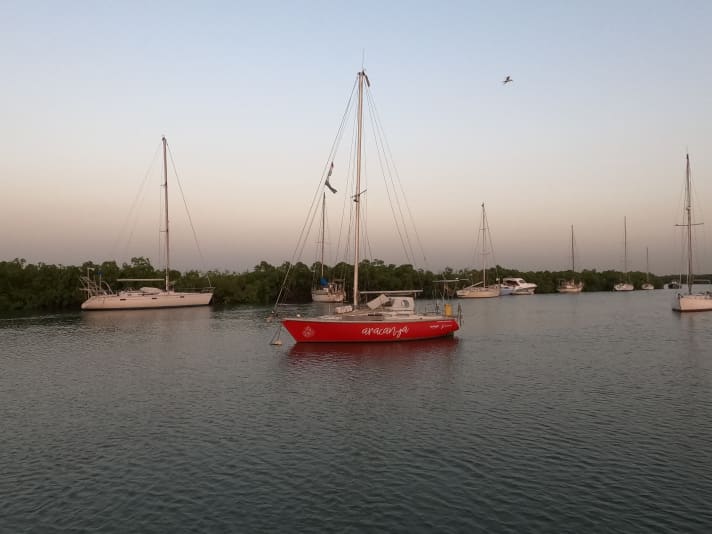
This concludes the three chapters "With the 'Aracanga' from Germany to The Gambia", "Home leave" and "With the 'Ivalu' from Germany to The Gambia". All four of us are a little sad to be breaking up our multi-generational crew, but at the same time we are looking forward to the fourth chapter of our journey: "Back on the 'Aracanga'".
We stay in The Gambia for two months, move back to our boat, see friends and refit our yacht. Then we move on, heading west, across the Atlantic to Grenada in the Caribbean. All the documents have been completed and sent off, all we need is a coronavirus test and we can cast off. We wait on the shore in a pub that is poorly lit by candlelight due to a lack of electricity for the friendly gentleman with the cotton buds to test us for coronavirus. "Good evening, I'm Ibrahim from the Ministry of Health. Do you have corona?"
(to be continued)
Further information, pictures and articles about the voyage of the "Aracanga" at Ahoy.blog .

